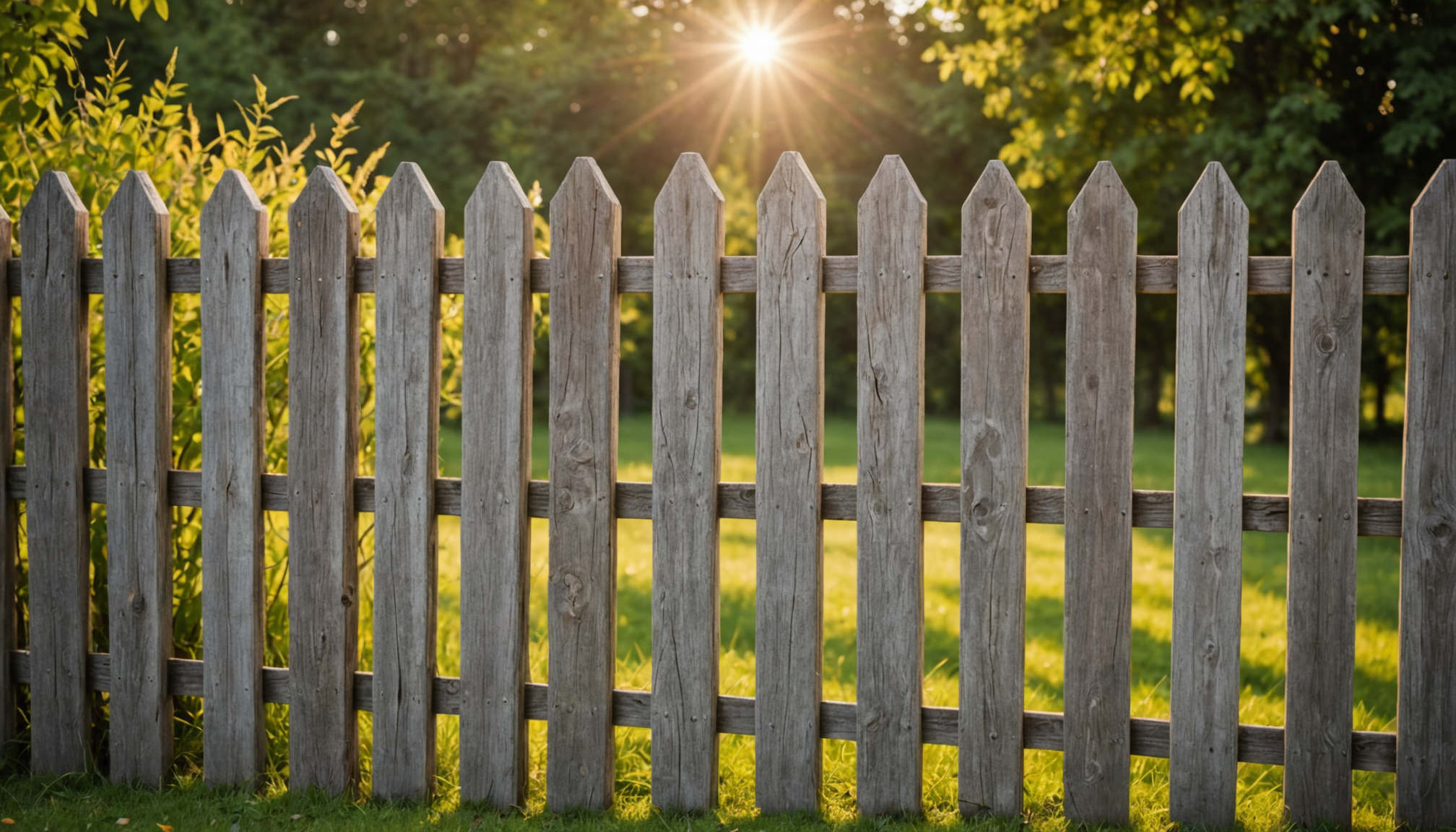When it comes to replacing your fence, the first critical step is selecting the best materials that suit both your needs and budget. The choice of materials will significantly affect the durability, appearance, and maintenance requirements of your new fence. Understanding the characteristics of different materials will empower you to make an informed decision that aligns with the aesthetic and functional demands of your property.
Several materials are commonly used for fencing, each offering unique benefits and downsides. Here’s a comparative analysis to help guide your choice:
| Material | Pros | Cons |
| Wood |
|
|
| Vinyl |
|
|
| Metal (Aluminum/Wrought Iron) |
|
|
| Composite |
|
|
When deciding on the right material, consider the aesthetic you want to achieve; are you looking for a traditional, rustic charm or a sleek, modern design? If budget constraints are a primary concern, wood often offers the most cost-effective solution, especially for large areas. However, if longevity and minimal upkeep are your priorities, investing a little more upfront for a material like vinyl or metal could be wise.
Your smart home isn’t just about the technology inside; the exterior, including your fence, plays a pivotal role in the overall appeal and efficiency of your property. By thoughtfully selecting the fencing material now, you ensure that your investment complements your smart home’s value, creating a cohesive look while providing the functionality you need.
evaluating your current fence
Before embarking on the process of replacing your fence, it’s essential to evaluate the current structure. This critical step not only helps determine the extent of the work needed but also ensures you allocate your budget wisely by reusing parts of the existing fence if possible. Here’s a step-by-step guide to evaluating your current fence:
- Inspect for Structural Integrity: Start by walking along the length of your fence, carefully inspecting each section for signs of damage or wear. Look for leaning posts, broken boards, or sections that have become unsteady. Use a level to check any suspected areas for proper alignment. Identifying these issues early can help you decide whether a complete replacement is necessary or if repairs could suffice.
- Check for Rot and Pest Damage: Especially if you have a wooden fence, it’s crucial to examine the posts and lower sections for rot and insect infestations, such as termites. Soft spots, noticeable holes, or powdery residue often indicate these problems. Use a screwdriver to lightly prod areas that are suspect to see if the material is compromised.
- Assess Weathering and Wear: Consider the effects of weather exposure over the years. Look for signs of rust on metal fences, fading paint on wood, or any warping of materials like vinyl and composite. Pay attention to the fence’s finish and hardware, which may have been weakened over time due to the elements.
- Evaluate Gate Functionality: The gate is often the most utilized part of your fence. Check that it opens and closes smoothly without scraping the ground or sagging. Ensure the latches and hinges are in good working order and free of rust or damage. Gates that don’t function properly may indicate foundational issues or need replacement parts.
- Consider Overall Aesthetics: Reflect on whether the current fence complements your home’s design and landscape, particularly if you’ve made other updates like a smart home system or exterior renovations. Aesthetic mismatch could be a sign that a new style or material is needed, aligning the fence with your desired visual and functional needs.
Once this evaluation process is complete, you can better determine whether a full replacement is necessary or if selective repairs will suffice. For some, replacing an older structure may present an opportunity to upgrade to a more durable, modern material that’s low maintenance and aligns with your property’s aesthetic, while others might find a simple repair more budget-friendly. In any case, a careful evaluation ensures that your fence replacement project starts off on a solid foundation, paving the way for a successful outcome.
planning the layout
A well-thought-out layout is crucial when it comes to replacing your fence, giving you the chance to enhance both the functionality and appearance of your outdoor space. Before breaking ground, take the time to consider several factors that will ensure your new fence meets both practical needs and aesthetic desires.
First, assess your property’s boundaries. This step is essential to avoid potential legal issues and maintain good relations with your neighbors. Use property maps or consult with a surveyor to confirm, ensuring you don’t mistakenly encroach on neighboring land. Engaging in open communication with neighbors early on can also help address any concerns or preferences they might have about the new structure, fostering a positive community relationship.
Consider the purpose your fence will serve, as this will heavily influence the layout. Are you prioritizing privacy, security, or simply looking to delineate property lines? For homeowners looking to create a haven of tranquility, strategic placement of a privacy fence can enhance seclusion without sacrificing style. Alternatively, if security is a top priority, a layout designed to minimize access points while maximizing visibility can enhance safety. Your fence should harmonize with existing structures and landscaping, such as gardens, patios, or a backyard pool, creating a cohesive outdoor environment that aligns with your lifestyle needs.
Take into account the environmental conditions that might affect your fence. If your area is prone to harsh weather, such as strong winds or heavy rainfall, plan for a layout that enhances the fence’s durability. This might involve considering wind-resistant designs or positioning the fence to effectively channel water flow away from critical areas. The careful use of natural elements, such as hills or existing trees, can further enhance stability and add to the visual appeal.
When planning your layout, mark the locations of gates and other access points. These are crucial for ensuring smooth and convenient movement around your property. Consider their size and position in relation to paths, driveways, and even external areas like a neighbor’s yard, avoiding any potential obstructions. A well-designed entryway enhances the fence’s functionality and ensures the completed layout integrates seamlessly into daily use.
Additionally, factor in the impact of your chosen materials on the layout. Each material offers unique benefits and requires different installation considerations. For example, while wood can be cut to fit irregular landscapes easily, materials like vinyl might need a more strategic approach to accommodate contours. Selecting materials that complement your property’s existing design helps establish an aesthetically pleasing and efficient layout.
By addressing these elements thoughtfully, you ensure that your new fence installation not only fits your property perfectly but also enhances your outdoor living space. This planning phase sets the stage for a successful project, maximizing your return on investment without unexpected surprises or complicated adjustments down the line. A well-planned layout is integral in crafting a fence that serves as both a functional boundary and a stylish addition to your home.
tools and equipment needed
Embarking on a fence replacement project requires the right set of tools and equipment to ensure efficiency and effectiveness. Preparing your toolkit in advance is a critical step in the process, as it minimizes delays and streamlines the installation. Whether you’re a seasoned DIY enthusiast or taking on this kind of project for the first time, having the right tools on hand is invaluable.
First, ensure that you have the basics: a measuring tape, level, and a set of carpenter’s pencils. These tools are essential for marking out your fence’s layout accurately, ensuring its position aligns with your property’s boundaries. The tape is particularly important for confirming dimensions and spacing between posts, helping avoid unnecessary adjustments later.
For excavation, post hole diggers or a power auger are crucial. These tools enable you to dig holes for your fence posts efficiently, especially when dealing with extensive lengths of fencing or challenging soil conditions. A power auger is particularly effective for tougher terrains or larger projects, significantly reducing physical strain and time spent on this task.
Once holes are prepared, a mix of tools will aid in setting the posts correctly. A spirit level ensures that posts are vertically aligned, while shovels and trowels can help in backfilling and compacting the soil around the base to provide stability. For materials requiring mixing, such as concrete, consider having a wheelbarrow and hoe ready for quick and efficient preparation and pouring.
Depending on your chosen fencing material, you might also need specific tools. For instance, if you’re installing a wooden fence, a handsaw or circular saw can be invaluable for cutting boards to the desired length. Additionally, a hammer or nail gun is necessary to fasten parts securely. For vinyl or metal fences, a power drill with appropriate bits and screws will be essential for assembly and securing panels.
A crucial but often overlooked item in your toolkit is personal protective equipment (PPE). Safety glasses, gloves, and sturdy footwear protect you from the various hazards of construction work, ensuring a safe working environment. Additionally, ear protection is recommended when using loud, power-operated tools like drills or saws.
Take the opportunity to include specialized equipment if your layout requires it. For example, if you choose a fencing design that includes curves or requires more precision cuts, invest in a jigsaw or a fence tensioner for chain-link options. These tools handle unique challenges and achieve a professional finish that aligns with your vision.
Also, remember to have auxiliary tools like clamps, crowbars, and a toolbox for small essentials such as nails, screws, and brackets. These not only help in assembling the fence but also in making any minor adjustments during the process, ensuring a seamless and secure installation.
By gathering these tools and ensuring they’re in working condition before you start, you set your project up for success. Being well-prepared grants you the freedom to focus on executing your replacement with precision, especially if it’s integrating with modern features of a smart home. A fully equipped workspace not only complements your skills but also optimizes the project timeline, allowing you to replace your fence efficiently while sticking to your budget without needing to make unexpected runs to the hardware store during critical phases of the installation.
installation tips and tricks
With all preparations made, the focus now shifts to the actual installation, a phase where attention to detail ensures the durability and aesthetic appeal of your new fence. First, start by marking the positions for your posts, using the layout plan as your guide. This step is crucial to maintain alignment and evenly distribute space, avoiding gaps that might not just affect the appearance but also the structural integrity of the fence. Make sure to double-check your measurements, as a mistake at this stage can lead to costly corrections later.
When digging the post holes, ensure they are deep enough to provide stability against wind and other environmental factors. A general rule is to dig the holes to about a third of the total post height for maximum support. If dealing with sandy or loose soil, consider additional support such as gravel bases or compacting techniques to prevent shifting.
Set each post in place with precision. Use a level frequently to confirm that each post is perfectly vertical. This is especially crucial for properties with smart home integrations where the aesthetic and technological appeal of a home is complemented by the precision and professionalism of well-installed fencing. Secure the posts in the ground with quick-set concrete for a firm anchorage, allowing it to cure as instructed before proceeding with attaching panels or rails.
Moving onto the attachment of fencing panels or rails, if using wood, ensure each piece is securely fastened with nails or screws, checking alignment consistently. For vinyl or metal fences, follow the manufacturer’s instructions closely, as improper installation can compromise stability. Use clamps to hold sections in place as you work, and take care to tighten screws sufficiently without overtightening, which can damage the materials.
As you work along the fence line, periodically step back to view your progress from a distance. This practice helps maintain a consistent appearance and ensures that your fence enhances the visual appeal of your property. If your project includes installing gates, make sure they operate smoothly and are securely latched, aligning properly within the fence lines for optimal functionality and security.
Consider the use of any protective finishes, especially on wooden fences. Applying a sealant or paint can extend the lifespan of the materials, providing a further safeguard against the elements and preserving the aesthetic integrity of your investment.
Cabinets of neighbors might need to be consulted if fencing is shared or directly adjacent to neighboring properties. This collaborative effort ensures mutual satisfaction and maintains a harmonious relationship, avoiding disputes that might arise from fencing installations that affect both parties.
Throughout the installation, keep safety at the forefront. Use appropriate safety gear, take breaks as needed to avoid fatigue, and maintain a clutter-free working area to prevent accidents. A careful attention to detail, coupled with the right tools and a structured approach, ensures that the outcome is not just a new fence, but a valuable addition to your home that contributes to comfort, privacy, and aesthetic harmony, reinforcing both the functional and decorative aspects of your property.
In conclusion, replacing a fence requires a balance of careful planning, the right materials, and precise installation techniques to achieve a durable, aesthetic outcome. Whether your goal is to enhance privacy, security, or simply update the look of your home, taking the time to evaluate your existing structure, plan an effective layout, and gather the necessary tools sets the stage for success. By considering both practical needs and personal preferences, you can ensure your new fence complements your property and adds value to your home, blending seamlessly with your environment while meeting modern demands such as smart home integration.


